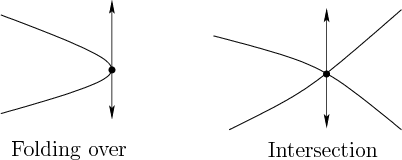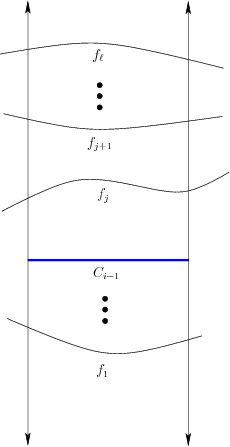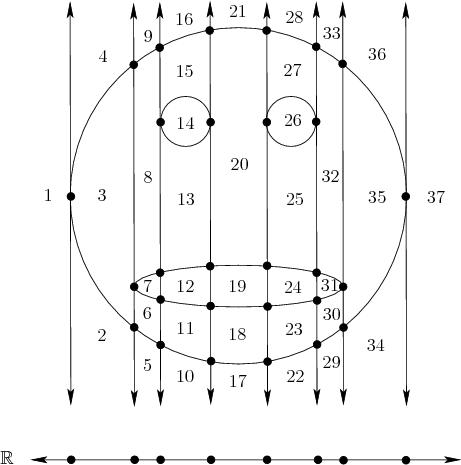
Next: Solving a motion planning Up: 6.4.2 Cylindrical Algebraic Decomposition Previous: One-dimensional decomposition
Now consider constructing a cylindrical algebraic decomposition for
![]() (note the decomposition is actually semi-algebraic). Figure
6.35 shows an example for
(note the decomposition is actually semi-algebraic). Figure
6.35 shows an example for
![]() . First consider
how to iteratively project the polynomials down to
. First consider
how to iteratively project the polynomials down to
![]() to ensure
that when the decomposition of
to ensure
that when the decomposition of
![]() is constructed, the
sign-invariant property is maintained. The resulting decomposition
corresponds to a singular complex.
is constructed, the
sign-invariant property is maintained. The resulting decomposition
corresponds to a singular complex.
 |
There are two cases that cause cell boundaries to be formed, as
shown in Figure 6.33. Let
![]() denote the
original set of polynomials in
denote the
original set of polynomials in
![]() that are used to
define the semi-algebraic set (or Tarski sentence) in
that are used to
define the semi-algebraic set (or Tarski sentence) in
![]() . Form a
single polynomial
. Form a
single polynomial
![]() . Let
. Let
![]() , which is also a polynomial. Let
, which is also a polynomial. Let
![]() , which is the greatest common divisor of
, which is the greatest common divisor of ![]() and
and
![]() . The set of zeros of
. The set of zeros of ![]() is the set of all points that are
zeros of both
is the set of all points that are
zeros of both ![]() and
and ![]() . Being a zero of
. Being a zero of ![]() means
that the surface given by
means
that the surface given by ![]() does not vary locally when perturbing
does not vary locally when perturbing
![]() . These are places where a cell boundary needs to be formed
because the surface may fold over itself in the
. These are places where a cell boundary needs to be formed
because the surface may fold over itself in the ![]() direction, which
is not permitted for a cylindrical decomposition. Another place where
a cell boundary needs to be formed is at the intersection of two or
more polynomials in
direction, which
is not permitted for a cylindrical decomposition. Another place where
a cell boundary needs to be formed is at the intersection of two or
more polynomials in
![]() . The projection technique from
. The projection technique from
![]() to
to
![]() generates a set,
generates a set,
![]() , of polynomials in
, of polynomials in
![]() that satisfies these requirements. The
polynomials
that satisfies these requirements. The
polynomials
![]() have the property that at least one
contains a zero point below every point in
have the property that at least one
contains a zero point below every point in
![]() for which
for which
![]() and
and
![]() , or polynomials in
, or polynomials in
![]() intersect. The projection method that constructs
intersect. The projection method that constructs
![]() involves computing principle subresultant coefficients, which
are covered in [77,853]. Resultants, of which the
subresultants are an extension, are covered in [250].
involves computing principle subresultant coefficients, which
are covered in [77,853]. Resultants, of which the
subresultants are an extension, are covered in [250].
The polynomials in
![]() are then projected to
are then projected to
![]() to
obtain
to
obtain
![]() . This process continues until
. This process continues until
![]() is
obtained, which is a set of polynomials in
is
obtained, which is a set of polynomials in
![]() . A
one-dimensional decomposition is formed, as defined earlier. From
. A
one-dimensional decomposition is formed, as defined earlier. From
![]() , a single polynomial is formed by taking the product, and
, a single polynomial is formed by taking the product, and
![]() is partitioned into 0-cells and
is partitioned into 0-cells and ![]() -cells. We next describe
the process of lifting a decomposition over
-cells. We next describe
the process of lifting a decomposition over
![]() up to
up to
![]() .
This technique is applied iteratively until
.
This technique is applied iteratively until
![]() is reached.
is reached.
Assume inductively that a cylindrical algebraic decomposition has been
computed for a set of polynomials
![]() in
in
![]() . The decomposition consists of
. The decomposition consists of ![]() -cells for
which
-cells for
which
![]() . Let
. Let
![]() . For each one of the
. For each one of the ![]() -cells
-cells ![]() , a
cylinder over
, a
cylinder over ![]() is defined
as the
is defined
as the ![]() -dimensional set
-dimensional set
| (6.23) |
| (6.24) |
| (6.25) |
| (6.26) |
| (6.27) |
 |
 |
Note that the cells do not necessarily project onto a rectangular set,
as in the case of a higher dimensional vertical decomposition. For
example, a generic ![]() -cell
-cell ![]() for a decomposition of
for a decomposition of
![]() is
described as the open set of
is
described as the open set of
![]() such that
such that
The resulting decomposition is sign invariant, which allows the
decision and quantifier-elimination problems to be solved in finite
time. To solve a decision problem, the polynomials in
![]() are
evaluated at every sample point to determine whether one of them
satisfies the Tarski sentence. To solve the quantifier-elimination
problem, note that any semi-algebraic sets that can be constructed
from
are
evaluated at every sample point to determine whether one of them
satisfies the Tarski sentence. To solve the quantifier-elimination
problem, note that any semi-algebraic sets that can be constructed
from
![]() can be defined as a union of some cells in the
decomposition. For the given Tarski sentence,
can be defined as a union of some cells in the
decomposition. For the given Tarski sentence,
![]() is formed
from all polynomials that are mentioned in the sentence, and the cell
decomposition is performed. Once obtained, the sign information is
used to determine which cells need to be included in the union. The
resulting union of cells is designed to include only the points in
is formed
from all polynomials that are mentioned in the sentence, and the cell
decomposition is performed. Once obtained, the sign information is
used to determine which cells need to be included in the union. The
resulting union of cells is designed to include only the points in
![]() at which the Tarski sentence is TRUE.
at which the Tarski sentence is TRUE.
Steven M LaValle 2012-04-20